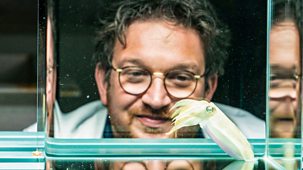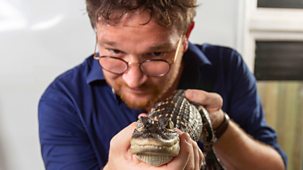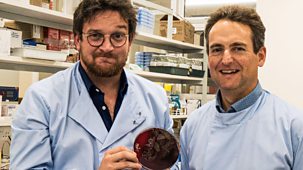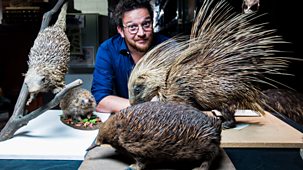
Series 1: 5. Defence
What is the most toxic animal on earth? How are porcupine quills helping us in medicine? Why is a rhino armour plated, and it is not to protect them from lions? \n\nProfessor Ben Garrod discovers the complex ways, from camouflage to deadly toxins, in which the skin helps defend animals against threats of all kinds. From the barbed quills of the North American porcupine to the battering ram of a rhino’s horn, the skin has developed an impressive armoury of weapons and warnings to keep predators at bay. \n\nWith experiments and specialist factual insight, Professor Ben Garrod reveals the toughest and most resilient of animals defend themselves through their skin. One of the most iconic warnings in nature is that of the rattlesnake. Ben takes a teaching sample of a rattlesnake’s tail to the University of Bristol to test just how fast it can vibrate. He uncovers how poison-dart frogs produce their toxins, and how cuttlefish are the masters of disguise when it comes to hiding in plain sight.
Source: BBC 4
Most recent episodes of Secrets of Skin
Secrets Of Skin
Series 1: 6. Sensing
Professor Ben Garrod explores how some snakes can see using heat, how crocodiles feel through their jaws and how some animals use electricity to navigate their world - and it is ...
03-08-2023
BBC 4
Secrets Of Skin
Series 1: 5. Defence
What is the most toxic animal on earth? How are porcupine quills helping us in medicine? Why is a rhino armour plated, and it is not to protect them from lions? \n\nProfessor Be ...
02-08-2023
BBC 4
Secrets Of Skin
Series 1: 4. Communication
Why are male mandrill faces (big bold primates from West Africa) red and blue? How are birds' feathers so colourful? What do ringtail lemurs do to talk to one another? Their ski ...
01-08-2023
BBC 4
Secrets Of Skin
Series 1: 3. Protection
How does a giraffe stay cool? What are different porcupine quills teaching us about medicine? What makes some people more likely to be bitten by mosquitoes than others? All the ...
31-07-2023
BBC 4
Secrets Of Skin
Series 1: 2. Moving
What makes sharks built for speed? How do snakes move without limbs? How do sugar gliders fly without feathers? The answer all lies in their skin. \n\nProfessor Ben Garrod uncov ...
27-07-2023
BBC 4
Secrets Of Skin
Series 1: 1. Adaptability
Skin is an incredible, multi-function organ that science is still learning so much about. It has adapted to allow animals to conquer virtually every habitat on the planet. \n\nI ...
26-07-2023
BBC 4
Most popular episodes of Secrets of Skin
Secrets Of Skin
Series 1: 3. Protection
How does a giraffe stay cool? What are different porcupine quills teaching us about medicine? What makes some people more likely to be bitten by mosquitoes than others? All the ...
31-07-2023
BBC 4
Secrets Of Skin
Series 1: 1. Adaptability
Skin is an incredible, multi-function organ that science is still learning so much about. It has adapted to allow animals to conquer virtually every habitat on the planet. \n\nI ...
26-07-2023
BBC 4
Secrets Of Skin
Series 1: 4. Communication
Why are male mandrill faces (big bold primates from West Africa) red and blue? How are birds' feathers so colourful? What do ringtail lemurs do to talk to one another? Their ski ...
01-08-2023
BBC 4
Secrets Of Skin
Series 1: 2. Moving
What makes sharks built for speed? How do snakes move without limbs? How do sugar gliders fly without feathers? The answer all lies in their skin. \n\nProfessor Ben Garrod uncov ...
27-07-2023
BBC 4
Secrets Of Skin
Series 1: 5. Defence
What is the most toxic animal on earth? How are porcupine quills helping us in medicine? Why is a rhino armour plated, and it is not to protect them from lions? \n\nProfessor Be ...
02-08-2023
BBC 4
Secrets Of Skin
Series 1: 6. Sensing
Professor Ben Garrod explores how some snakes can see using heat, how crocodiles feel through their jaws and how some animals use electricity to navigate their world - and it is ...
03-08-2023
BBC 4






